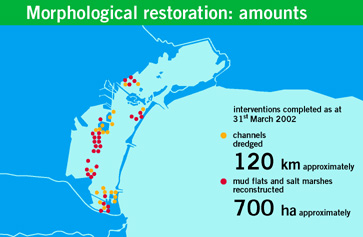|
INTRODUCTION
The survival
of ecosystems depends on the maintenance of a very delicate balance between the
various components of the natural environment. What makes the Venice lagoon a
special environment, in comparison with any other ecosystem, is certainly the
historical and monumental value of Venice but also the quantity of historical
information available, given the fact that the existence of Venice and its military
and sanitary safety have always depended on the environment, justifying and encouraging
the study and understanding of the environment. 
The Venetians
undertook the immense task of delivering the lagoon from the dominion of the
rivers and defending it from the sea. For centuries, they sought and found,
lost then re-conquered an impossible equilibrium. But the 20th century gave
us a city of Venice and its lagoon definitively at risk.
As time goes
by, the lagoon is becoming deeper (more than 60 centimetre in one century), 50%
of the marshland existing at the beginning of 1900 has been lost, the volume of
water exchanged twice a day between the sea and the lagoon has increased, the
volume of pollutants discharged by the industry, agriculture and the cities has
likewise increased, the works built in the past centuries to protect it against
the sea were gradually undermined, the city is flooded ever more frequently and
with ever greater intensity. Meanwhile, the use of the lagoon has rapidly increased: the port of Venice has grown to become the fifth in Italy, fishing
in the lagoon is today a real industry, and each year 6 million tourists visit
the city of Venice.
The
increased flood phenomena are also partly due to the changes in land and sea
levels: the relative level of the land dropped by 23 cm with respect to the sea
and the tide rose by a further 8 cm as a result of major morphological
modifications occurring in the lagoon basin up until the 1970s. At the
beginning of the 20th century, the lowest parts of the city flooded an average
of 90 times (calculated over 100 years).
This average has now risen to 3,900.
The repetition of the
tragic flood of 1966, when the entire city was under a metre of water, was
considered a remote possibility (once in 1000 years); today, the same event
could take place every 140 years and, with a 20 cm rise in sea level, every 40 years. Extreme events are no longer
a remote possibility.
During the last thirty years, the
uniqueness of the Venice case and the recognition of the need for the physical
defence of a city considered priceless to the world, has produced an exceptional
body of ordinary and special legislation, making the safeguarding of Venice a
matter of priority national interest and linking the problem of protecting it
from high waters to all the solutions for the restoration of environmental
balance and socio-economic development envisaged for the city.
The need to solve many different
problems, to understand their causes, and to identify the remedial actions,
made it necessary to develop a better knowledge of the dynamics of each component
of the ecosystem and therefore, to carry out, for each of these components,
studies on the actual situation and on the past trend, experiments in the
laboratory and in-situ, and to indicate the possible future trend with and
without remedial interventions.
The interventions that are part of
the overall master plans can be classified under three main headings:
·
Interventions
for the protection of the coastline from the sea storms [Click
here]
·
Interventions
for the restoration of the environment [Click
here]
·
Interventions
for the protection against flooding [Click here]
Services:
|
General Plan of the interventions, studies and
investigations, coordination of studies and tests carried out by third parties,
preliminary and detailed designs of all the works, environmental impact studies
and definition of remedial measures, technical assistance, liaison with national
and international organizations, public awareness programmes
|
Period:
|
1984-present day
|
|